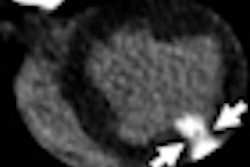Attorneys in Huntsville, AL, have filed suit in federal court against GE Healthcare of Chalfont St. Giles, U.K., on behalf of a patient who allegedly received excessive radiation during a CT perfusion head scan for suspected stroke.
The patient, Becky Coudert, will be the lead plaintiff in an Alabama-based class-action lawsuit representing more than 300 patients, including many of the 260 patients who allegedly received CT overdoses at Cedars-Sinai Medical Center in Los Angeles. A previous class-action suit filed in California has been withdrawn, attorneys representing the plaintiff said.
The class-action complaint was filed on December 15 in the U.S. District Court for the Northern District of Alabama on behalf of Coudert, who received a CT perfusion scan in August 2009 at Huntsville Hospital for suspected stroke. The lawsuit was filed by Huntsville, AL-based Watson, McKinney & Artrip.
The attorneys allege that Coudert received a dose of 5.9 Gy during her perfusion study, leaving her with persistent and debilitating symptoms including memory loss, depression, and dizziness. The dose was about 1,000 times the normal exposure, according to Rick Patterson of law firm Owen, Patterson & Owen in Los Angeles, which is working in cooperation with the Alabama attorneys on the case.
The patient's one visible mark from the overexposure was hair loss in a ring that extended around the head and over the temples. Coudert initially contacted the Huntsville firm after she recognized her own symptoms in news reports of radiation overdoses at Cedars-Sinai, Patterson said.
Plaintiffs are asking for $5 million for the purposes of monitoring any future cancers that might arise in the approximately 300 patients, in addition to changes in scanner design and imaging personnel practices, and damages that will vary for each case, Patterson said.
The lawsuit claims that GE's scanners should have been designed to provide more warning when excess radiation beyond a normal protocol is about to be applied, according to Patterson.
"The machine doesn't have a beeper on it" to warn of a pending high-dose exam, Patterson said, nor does it have any kind of prompting system to ensure that the physician or technologist knows that a high-dose exam is about to be delivered.
In a statement, GE said that no scanner malfunction has been identified in any of the Alabama or Cedars-Sinai cases, and patient dose was determined solely by the medical team onsite at the hospitals. The company is aware of litigation regarding the Alabama incident but is unable to comment on the specifics as a matter of policy.
"Although GE Healthcare continues its internal investigation, we confirm that there were no malfunctions or defects in any of the GE Healthcare equipment involved," the statement said. "GE has also confirmed that the GE scanners at Huntsville Hospital are operating as intended. As with all CT head perfusion scans, the radiation dose delivered was a decision made by healthcare providers during the treatment of stroke patients. This decision was based on the medical expertise of the Huntsville staff as well as the needs of the patients."
GE said it is also cooperating with U.S. Food and Drug Administration (FDA) officials, and is working closely with Huntsville Hospital to review and optimize its CT protocols per the FDA's October and December recommendations. In October, the FDA said it had learned of the CT overdose cases at Cedars-Sinai; earlier this month, it said that other cases had come to light in the U.S., including some at an Alabama hospital.
GE "continues to offer dose-reducing technologies and expand key CT training initiatives to raise awareness of dose optimization and use of appropriate exam protocols," the statement continued. The company's CT products require that users carefully evaluate user-defined scanning protocols, and the recommended dose is an "important clinical decision" that should be made by qualified medical personnel.
In addition to Coudert, Patterson said that approximately 60 people scanned at Huntsville Hospital have come forward saying they may have been overdosed during perfusion CT scans -- largely perfusion CT studies of the head undertaken to rule out stroke.
Patterson said the scanners are serviced and calibrated in a routine annual or biannual process that involves the manufacturer -- and that the Huntsville scanner had recently been adjusted before the patient was treated.
"Like so many effective medical tools, devices, and pharmaceuticals, the more beneficial they are, they also have a contrasting danger side," Patterson said. "We hope that one of the results of the review of these cases ... will be a focus on safety systems, both in consistency of prescribed doses and the frequency of doses" to the patient, "resulting in improved practices," he said.
By Eric Barnes
AuntMinnie.com staff writer
December 18, 2009
Related Reading
Studies spotlight high CT radiation dose, increased cancer risk, December 14, 2009
FDA finds new cases of CT radiation overexposure, December 7, 2009
Cedars-Sinai raises tally of radiation overdose cases, November 13, 2009
Class-action lawsuit hits Cedars-Sinai, GE over CT dose, October 20, 2009
FDA CT overdose probe focuses on Cedars-Sinai, October 13, 2009
Copyright © 2009 AuntMinnie.com




















